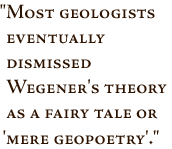

|
Except for a few converts, and those like Cloos who couldn't accept the concept but was clearly fascinated by it, the international geological community's reaction to Wegener's theory was militantly hostile. American geologist Frank Taylor had published a similar theory in 1910, but most of his colleagues had simply ignored it. Wegener's more cogent and comprehensive work, however, was impossible to ignore and ignited a firestorm of rage and rancor. Moreover, most of the blistering attacks were aimed at Wegener himself, an outsider who seemed to be attacking the very foundations of geology.
Because of this abuse,Wegener could not get a professorship at any German university. Fortunately, the University of Graz in Austria was more tolerant of controversy, and in 1924 it appointed him professor of meteorology and geophysics. In 1926 Wegener was invited to an international symposium in New York called to discuss his theory. Though he found some supporters, many speakers were sarcastic to the point of insult. Wegener said little. He just sat smoking his pipe and listening. His attitude seems to have mirrored that of Galileo who, forced to recant Copernicus' theory that the Earth moves around the sun, is said to have murmured, "Nevertheless, it moves!" Scientifically, of course, Wegener's case was not as good as Galileo's, which was based on mathematics. His major problem was finding a force or forces that could make the continents "plow around in the mantle," as one critic put it. Wegener tentatively suggested two candidates: centrifugal force caused by the rotation of the Earth, and tidal-type waves in the Earth itself generated by the gravitational pull of the sun and moon. He realized these forces were inadequate. "It is probable the complete solution of the problem of the forces will be a long time coming," he predicted in his last (1929) revision. "The Newton of drift theory has not yet appeared." Wegener noted, however, that one thing was certain: The forces which displace continents are the same as those which produce great fold-mountain ranges. Continental drift, faults and compressions, earthquakes, volcanicity, [ocean] transgression cycles and [apparent] polar wandering are undoubtedly connected on a grand scale. Wegener's final revison cited supporting evidence from many fields, including testimonials from scientists who found his hypothesis resolved difficulties in their disciplines much better than the old theories. Climatology was one such discipline. Fossils and geologic evidence show that most of the continents used to have startlingly different climates than they do today. Wegener thought continental drift was the key to these climatic puzzles, so he and Vladimir Koppen plotted ancient deserts, jungles, and ice sheets on paleogeographic maps based on Wegener's theory. Suddenly the pieces of the puzzles fell into place, producing simple, plausible pictures of past climates. Evidence of the Permo-Carboniferous ice-age era that peaked some 280 million years ago, for example, was scattered over almost half the Earth, including the hottest deserts. On Wegener's map, however, it clustered neatly around the South Pole—because Africa, Antarctica, Australia, and India had once comprised a Southern Hemisphere supercontinent (Gondwanaland). Wegener considered such paleoclimatic validation one of the strongest proofs of his theory. Conversely, continental drift has since become the organizing principle of paleoclimatology and other paleosciences. Unfortunately, though Wegener's explanation of the Permo-Carboniferous ice age impressed even his critics, the merit of much of the rest of his supporting evidence was not widely recognized at the time. As a result, most geologists eventually dismissed his theory as a fairy tale or "mere geopoetry." next: Vindication of a Visionary
|
 On the Shoulders of Giants
| ||